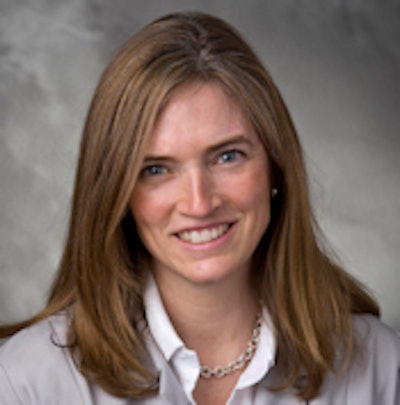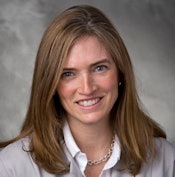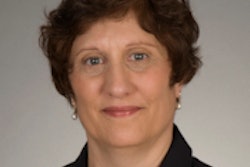
Adding digital breast tomosynthesis to mammography screening boosts the detection of invasive cancer by more than a third compared to mammography alone while reducing the number of false positives by 15%, according to a study in the June 25 issue of the Journal of the American Medical Association.
The research addresses a few of what critics call mammography's harms, such as the potential for overdiagnosis and anxiety caused by recalls -- although it's not clear that women themselves consider these to be barriers to screening, lead author Dr. Sarah Friedewald of Advocate Lutheran General Hospital in Park Ridge, IL, told AuntMinnie.com.
"It's frustrating to have people tell women that they're suffering because of false positives -- that they can't handle the anxiety," she said. "In general, the women I encounter in my practice are willing to go through some discomfort in order to be proactive about their breast health."
 Dr. Sarah Friedewald of Advocate Lutheran General Hospital.
Dr. Sarah Friedewald of Advocate Lutheran General Hospital.Diversity of practices
The study included data from 13 breast centers. Friedewald's group assessed recall rates, cancer detection rates, and positive predictive values for recall and biopsy across more than two years (March 2010 to December 2012). For the tomosynthesis exams, all 13 sites used the same technology -- Hologic's Selenia Dimensions -- which is the only DBT device approved by the U.S. Food and Drug Administration (JAMA, June 25, 2014, Vol. 311:24, pp. 2499-2507).
The diversity of practices included in the study is one of its strengths, Friedewald told AuntMinnie.com. The sites varied according to geography, academic versus nonacademic settings, and specialist and nonspecialist readers; they even differed in terms of whether the technology was adopted partially or completely during the study period.
"There have been a number of single-site tomosynthesis studies published, and they've all been very promising," she said. "But we wanted to evaluate how the technology is working across a variety of practice types."
The study included a total of 454,850 examinations, of which 281,187 were digital mammography and 173,663 were digital mammography plus tomosynthesis. With digital mammography, 29,726 patients were recalled; 5,056 biopsies resulted in a cancer diagnosis in 1,207 patients (of which 815 were invasive cancers and 392 were in situ cancers).
Those numbers improved with the combination of digital mammography and tomosynthesis: 15,541 patients were recalled, and 3,285 biopsies resulted in a cancer diagnosis in 950 patients (with 707 of these cases proving to be invasive and 243 in situ).
Friedewald and colleagues found that the combination of digital mammography and tomosynthesis not only reduced recalls, it increased both overall and invasive cancer detection rates while ductal carcinoma in situ rates remained the same.
| Screening with FFDM vs. FFMD + DBT per 1,000 patients | |||
| FFDM | FFDM plus DBT | Percent difference | |
| Recalls | 107 | 91 | -15% |
| Overall cancer detection | 4.2 | 5.4 | 29% |
| Invasive cancer detection | 2.9 | 4.1 | 41% |
| DCIS cancer detection | 1.4 | 1.4 | 0% |
"These results were nice to see, particularly because they're comparable to study data we've seen out of Europe," Friedewald told AuntMinnie.com. "It gives us a level of confidence that the combination of digital mammography plus tomosynthesis is finding the cancers we want to find."
In addition, the findings were similar across the variety of practices, Friedewald and colleagues wrote.
"Despite this diversity [of the centers], there was remarkably consistent improvement in measured screening outcomes when tomosynthesis was implemented," they wrote. "Moreover, the large volume of patients reflected collectively in this study provided statistical significance to critical measures of screening mammography performance not easily achievable in prior single-site studies given the relatively low prevalence of cancer in the screening population."
The study did find that tomosynthesis plus mammography increased the biopsy rate over mammography alone by 7%, from 18.1 biopsies per 1,000 cases to 19.3. But there was also a simultaneous 21% increase in the positive predictive value for biopsy, which reflected a higher yield of malignancy in women who underwent biopsy after the tomosynthesis/mammography combination, Friedewald's group wrote.
The end of FFDM?
The study adds considerable evidence to the current knowledge of how tomosynthesis performs in everyday practice in a variety of settings, wrote Dr. Etta Pisano of the Medical University of South Carolina and Dr. Martin Yaffe of the University of Toronto in an accompanying editorial in the same issue (pp. 2488-2489).
So what should women do? Should they seek screening with tomosynthesis over digital mammography? Should breast cancer screening centers convert to tomosynthesis and abandon digital mammography?
Not so fast, according to Pisano and Yaffe.
"Despite the promising results reported by Friedewald et al, the answer is still uncertain," they wrote. "For those who interpret the evidence to suggest that screening saves lives without undue false-positive results and overdiagnoses, this study contributes to the case for tomosynthesis over digital mammography. However, for those whose interpretation of the evidence leads to questioning the utility of screening mammography per se, this study may not provide sufficient evidence to change their opinion."




















